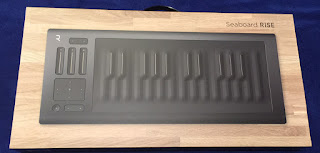I don’t
know how often new musical instruments are being invented. My guess is, not
very often. So when I had a chance to review the Roli Seaboard Rise keyboard
for Amazon, I was not sure what to expect. I’m always up for a musical
adventure, however, so I decided to expand my musical palette and resume and
try it out.
 |
| A very well packaged, good looking instrument. |
You will
notice that the instrument is vaguely laid out like a keyboard, with sharps and
flats between nominally longer keys, however, each key is actually not a key,
but a raised hillock (I don’t know what else to call it – it’s the convex
version of a trough) of silicone. You can try to play it like a keyboard, but
you will be sorely disappointed and you will notice also that keyboard
technique hardly transfers at all to the configuration of the instrument.
That’s because the entire black surface is the instrument. You can actually
sound each key by hitting, pressing, pushing, sliding, or otherwise coming in
contact with it with some kind of finger motion. You can also play above and
below the keys, and in between them as well. It’s actually quite unnerving at
first. Attempting to play it like a keyboard, you end up with distinct,
non-repetitive sounds across a wide spectrum of tonality. Any false move or
lazy finger action will affect the sound. It’s actually hard to believe how
difficult it is – at first.
 |
| The box can even work as a road case. Kind of. |
The
instrument comes with a program and sound module and while it is meant to be a
MIDI controller (kind of), I think it actually works better as a standalone
instrument. The best thing about the graphic interface is the sound curve at
the bottom of the screen for each sound. It shows where you are playing the
sound and approximately, what the range and frequency of the sound is. Since
each sound is playable across 10-and-a-half octaves, this turns out to be
pretty important, as some sounds turn into complete mush and wobble as they go
lower, while other sounds actually become inaudible as they go up. (No sense in
hitting the C above C above C above C above C above middle C if nobody can hear
it, right?) The program also allows individual tweaking of the sounds by
altering attack, fade, and things like that. Each mode has a four panel recall
feature, so you can always leave on untouched to keep the original in place
while you are working on altering the sound.
 |
| Looks kind of like a keyboard, but really, it's not. |
The depth
of this instrument is really incredible. Of course you can add other sounds to
your sound library and tweak them the same as you would the ones it comes with.
There’s even a dashboard for working on sounds more easily and quickly prior to
putting them back into the library. I’ve had this for about a week and I know
I’ve only scratched the surface, as I’m just having too much fun with what I
can get my hands on and brain around to want to invest the time to try some
different things. I have, however, printed out the manuals and I plan to start
mucking around with more features pretty soon. Honestly, I feel this instrument
can make a great piece of jazz performance gear, and I like how it will be
practically one of a kind if I am the first to get it out there and start
soling or comping with it.
 |
| Programmable sound. Awesome. |
This
thing is simply incredible. I don’t know what else I can say about it. As I
learn to use it and start to actually play and record, maybe some more
interesting things will come to light. Until then, I will say that, like me,
Roli may also be late to jazz, but they have invested an instrument that is
here now. I intend to make it work for me.




No comments:
Post a Comment